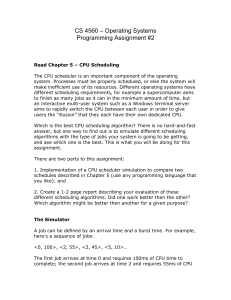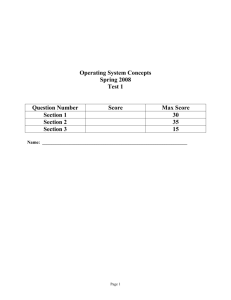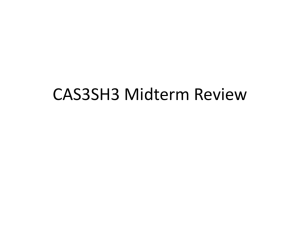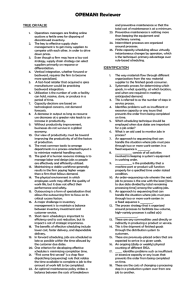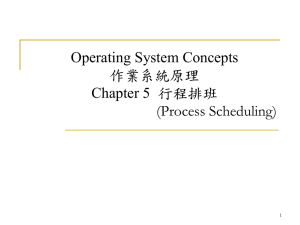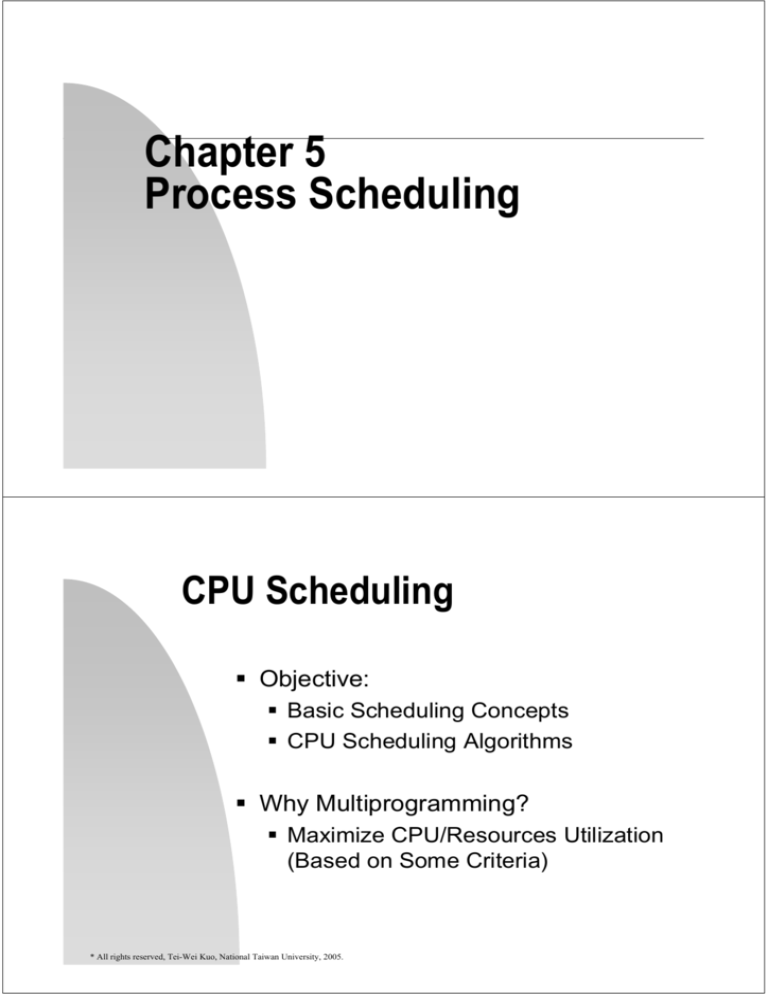
Chapter 5
Process Scheduling
CPU Scheduling
Objective:
Basic Scheduling Concepts
CPU Scheduling Algorithms
Why Multiprogramming?
Maximize CPU/Resources Utilization
(Based on Some Criteria)
* All rights reserved, Tei-Wei Kuo, National Taiwan University, 2005.
CPU Scheduling
Process Execution
CPU-bound programs tend to have a
few very long CPU bursts.
IO-bound programs tend to have
many very short CPU bursts.
CPU-Burst
New
Terminate
I/O-Burst
* All rights reserved, Tei-Wei Kuo, National Taiwan University, 2005.
CPU Scheduling
The distribution can help in selecting
an appropriate CPU-scheduling
algorithms
frequency
120
100
60
20
8
* All rights reserved, Tei-Wei Kuo, National Taiwan University, 2005.
24
16
Burst Duration (ms)
CPU Scheduling
CPU Scheduler – The Selection of
Process for Execution
A short-term scheduler
New
Terminated
dispatched
Ready
Running
Waiting
* All rights reserved, Tei-Wei Kuo, National Taiwan University, 2005.
CPU Scheduling
Nonpreemptive Scheduling
A running process keeps CPU until it
volunteers to release CPU
E.g., I/O or termination
Advantage
Easy to implement (at the cost of service
response to other processes)
E.g., Windows 3.1
* All rights reserved, Tei-Wei Kuo, National Taiwan University, 2005.
CPU Scheduling
Preemptive Scheduling
Beside the instances for non-preemptive
scheduling, CPU scheduling occurs
whenever some process becomes
ready or the running process leaves the
running state!
Issues involved:
Protection of Resources, such as I/O
queues or shared data, especially for
multiprocessor or real-time systems.
Synchronization
E.g., Interrupts and System calls
* All rights reserved, Tei-Wei Kuo, National Taiwan University, 2005.
CPU Scheduling
Dispatcher
Functionality:
Switching context
Switching to user mode
Restarting a user program
Dispatch Latency:
Must be fast
Stop a process
* All rights reserved, Tei-Wei Kuo, National Taiwan University, 2005.
Start a process
Scheduling Criteria
Why?
Different scheduling algorithms may
favor one class of processes over
another!
Criteria
CPU Utilization
Throughput
Turnaround Time: CompletionT-StartT
Waiting Time: Waiting in the ReadyQ
Response Time: FirstResponseTime
* All rights reserved, Tei-Wei Kuo, National Taiwan University, 2005.
Scheduling Criteria
How to Measure the Performance of
CPU Scheduling Algorithms?
Optimization of what?
General Consideration
Average Measure
Minimum or Maximum Values
Variance Æ Predictable Behavior
* All rights reserved, Tei-Wei Kuo, National Taiwan University, 2005.
Scheduling Algorithms
First-Come, First-Served Scheduling
(FIFO)
Shortest-Job-First Scheduling (SJF)
Priority Scheduling
Round-Robin Scheduling (RR)
Multilevel Queue Scheduling
Multilevel Feedback Queue Scheduling
Multiple-Processor Scheduling
* All rights reserved, Tei-Wei Kuo, National Taiwan University, 2005.
First-Come, First-Served
Scheduling (FCFS)
The process which requests the
CPU first is allocated the CPU
Properties:
Non-preemptive scheduling
CPU might be hold for an extended
period.
CPU
request
A FIFO ready queue
* All rights reserved, Tei-Wei Kuo, National Taiwan University, 2005.
dispatched
First-Come, First-Served
Scheduling (FCFS)
Example
Process
P1
P2
P3
Gantt
Chart
P1
0
P2 P3
0 3 6
CPU Burst Time
24
3
3
Average waiting time
P2 P3
24 27 30 = (0+24+27)/3 = 17
Average waiting time
P1
30 = (6+0+3)/3 = 3
*The average waiting time is highly affected by process CPU
burst times !
* All rights reserved, Tei-Wei Kuo, National Taiwan University, 2005.
First-Come, First-Served
Scheduling (FCFS)
Example: Convoy
Effect
CPU
I/O device
ready queue
idle
One CPU-bound
process + many
I/O-bound
processes
ready queue
All other processes wait for it
to get off the CPU!
* All rights reserved, Tei-Wei Kuo, National Taiwan University, 2005.
Shortest-Job-First Scheduling
(SJF)
Non-Preemptive SJF
Shortest next CPU burst first
Average waiting time
= (3+16+9+0)/4 = 7
process
P1
P2
P3
P4
P4 P1
0 3
CPU burst time
6
8
7
3
P3
9
P2
16
24
* All rights reserved, Tei-Wei Kuo, National Taiwan University, 2005.
Shortest-Job-First Scheduling
(SJF)
Nonpreemptive SJF is optimal when
processes are all ready at time 0
The minimum average waiting time!
Prediction of the next CPU burst time?
Long-Term Scheduler
A specified amount at its submission
time
Short-Term Scheduler
Exponential average (0<= α <=1)
τn+1 = α tn + (1-α) τn
* All rights reserved, Tei-Wei Kuo, National Taiwan University, 2005.
Shortest-Job-First Scheduling
(SJF)
Preemptive SJF
Shortest-remaining-time-first
Process
P1
P2
P3
P4
CPU Burst Time Arrival Time
8
0
4
1
9
2
5
3
P1 P2
P4
P1
P3
10
17
26
0 1
5
Average Waiting
Time = ((10-1) +
(1-1) + (17-2) +
(5-3))/4 = 26/4
= 6.5
* All rights reserved, Tei-Wei Kuo, National Taiwan University, 2005.
Shortest-Job-First Scheduling
(SJF)
Preemptive or Non-preemptive?
Criteria such as AWT (Average
Waiting Time)
0
1
or
Non-preemptive
AWT = (0+(10-1))/2
= 9/2 = 4.5
10
10 11
11
0
1 2
Preemptive AWT
= ((2-1)+0) = 0.5
* Context switching cost ~ modeling & analysis
* All rights reserved, Tei-Wei Kuo, National Taiwan University, 2005.
Priority Scheduling
CPU is assigned to the process
with the highest priority – A
framework for various scheduling
algorithms:
FCFS: Equal-Priority with TieBreaking by FCFS
SFJ: Priority = 1 / next CPU burst
length
* All rights reserved, Tei-Wei Kuo, National Taiwan University, 2005.
Priority Scheduling
Process
P1
P2
P3
P4
P5
CPU Burst Time
10
1
2
1
5
Average waiting time
= (6+0+16+18+1)/5 = 8.2
Gantt Graph
P2 P5
0 1
* All rights reserved, Tei-Wei Kuo, National Taiwan University, 2005.
Priority
3
1
3
4
2
P1
6
P3 P4
16 18 19
Priority Scheduling
Priority Assignment
Internally defined – use some
measurable quantity, such as the #
of open files, Average CPU Burst
Average I/O Burst
Externally defined – set by criteria
external to the OS, such as the
criticality levels of jobs.
* All rights reserved, Tei-Wei Kuo, National Taiwan University, 2005.
Priority Scheduling
Preemptive or Non-Preemptive?
Preemptive scheduling – CPU
scheduling is invoked whenever a
process arrives at the ready queue,
or the running process relinquishes
the CPU.
Non-preemptive scheduling – CPU
scheduling is invoked only when the
running process relinquishes the
CPU.
* All rights reserved, Tei-Wei Kuo, National Taiwan University, 2005.
Priority Scheduling
Major Problem
Indefinite Blocking (/Starvation)
Low-priority processes could starve
to death!
A Solution: Aging
A technique that increases the
priority of processes waiting in the
system for a long time.
* All rights reserved, Tei-Wei Kuo, National Taiwan University, 2005.
Round-Robin Scheduling (RR)
RR is similar to FCFS except that
preemption is added to switch between
processes.
ready
running
Interrupt at every time quantum (time slice)
Goal: Fairness – Time Sharing
CPU
FIFO…
The quantum is used up!
* All rights reserved, Tei-Wei Kuo, National Taiwan University, 2005.
New process
Round-Robin Scheduling (RR)
CPU Burst Time
24
Time slice = 4
3
3
Process
P1
P2
P3
P1 P2 P3 P1 P1 P1 P1 P1
0 4 7 10 14 18 22 26 30
AWT = ((10-4) + (4-0) + (7-0))/3
= 17/3 = 5.66
* All rights reserved, Tei-Wei Kuo, National Taiwan University, 2005.
Round-Robin Scheduling (RR)
Service Size and Interval
Time quantum = q Æ Service interval <= (n1)*q if n processes are ready.
IF q = ∞, then RR Æ FCFS.
IF q = ε, then RR Æ processor sharing. The
# of context switchings increases!
process
0
0
0
10
6
10
10
If context switch cost
= 10%
time quantum
* All rights reserved, Tei-Wei Kuo, National Taiwan University, 2005.
quantum context switch #
12
0
6
1
1
9
=> 1/11 of CPU is wasted!
Round-Robin Scheduling (RR)
Turnaround Time
process (10ms) quantum = 10
P1
P2
0
quantum = 1
0
10
20
30
0
10
20
30
30 0
10
20
30
10
10
P3
20
20
Average Turnaround Time
= (10+20+30)/3 = 20
ATT = (28+29+30)/3 = 29
=> 80% CPU Burst < time slice
* All rights reserved, Tei-Wei Kuo, National Taiwan University, 2005.
Multilevel Queue Scheduling
Partition the ready queue into
several separate queues =>
Processes can be classified into
different groups and permanently
assigned to one queue.
System Processes
Interactive Processes
…
Batch Processes
* All rights reserved, Tei-Wei Kuo, National Taiwan University, 2005.
Multilevel Queue Scheduling
Intra-queue scheduling
Independent choice of scheduling
algorithms.
Inter-queue scheduling
a. Fixed-priority preemptive scheduling
a. e.g., foreground queues always have absolute
priority over the background queues.
b. Time slice between queues
a. e.g., 80% CPU is given to foreground processes,
and 20% CPU to background processes.
c. More??
* All rights reserved, Tei-Wei Kuo, National Taiwan University, 2005.
Multilevel Feedback Queue
Scheduling
Different from Multilevel Queue
Scheduling by Allowing Processes to
Migrate Among Queues.
Configurable Parameters:
a. # of queues
b. The scheduling algorithm for each queue
c. The method to determine when to upgrade a
process to a higher priority queue.
d. The method to determine when to demote a
process to a lower priority queue.
e. The method to determine which queue a newly
ready process will enter.
*Inter-queue scheduling: Fixed-priority preemptive?!
* All rights reserved, Tei-Wei Kuo, National Taiwan University, 2005.
Multilevel Feedback Queue
Scheduling
Example
quantum = 8
quantum = 16
FCFS
*Idea: Separate processes with different CPU-burst
characteristics!
* All rights reserved, Tei-Wei Kuo, National Taiwan University, 2005.
Multiple-Processor Scheduling
CPU scheduling in a system with
multiple CPUs
A Homogeneous System
Processes are identical in terms of their
functionality.
Î Can processes run on any processor?
A Heterogeneous System
Programs must be compiled for
instructions on proper processors.
* All rights reserved, Tei-Wei Kuo, National Taiwan University, 2005.
Multiple-Processor Scheduling
Load Sharing – Load Balancing!!
A queue for each processor
Self-Scheduling – Symmetric
Multiprocessing
A common ready queue for all processors.
Self-Scheduling
Need synchronization to access common
data structure, e.g., queues.
Master-Slave – Asymmetric Multiprocessing
One processor accesses the system
structures Æ no need for data sharing
* All rights reserved, Tei-Wei Kuo, National Taiwan University, 2005.
Multiple-Processor Scheduling
Load Balancing
Push migration: A specific task periodically
checks for imbalance and migrate tasks
Pull migration: An idle processor pulls a
waiting task from a busy processor
Linux and FreeBSD do both!
Processor Affinity
The system might avoid process migration
because of the cost in invalidating or repopulating caches
Soft or hard affinity
* All rights reserved, Tei-Wei Kuo, National Taiwan University, 2005.
Multiple-Processor Scheduling
Symmetric Multithreading (SMT), i.e.,
Hyperthreading
A feature provided by the hardware
Several logical processors per
physical processor
Each has its own architecture state,
including registers.
Issues: Process Synchronization
* All rights reserved, Tei-Wei Kuo, National Taiwan University, 2005.
Multiple-Processor Scheduling –
SMT Superscalar
SMT
Utilization++
Throughput++
Performance++
time
occupied issue slot
unused issue slot
: 13
* All rights reserved, Tei-Wei Kuo, National Taiwan University, 2005.
: 10
: 11
Thread Scheduling
Two Scopes:
Process Contention Scope (PCS): m:1 or
m:m
Priority-Driven
System-Contention Scope (SCS): 1:1
Pthread Scheduling
PCS and SCS
Pthread_attr_setscope(pthread_attr_t *attr, int scope)
Pthread_attr_getscope(pthread_attr_t *attr, int *scope)
* All rights reserved, Tei-Wei Kuo, National Taiwan University, 2005.
Operating System Examples
Process Local Scheduling
E.g., those for user-level threads
Thread scheduling is done locally to
each application.
System Global Scheduling
E.g., those for kernel-level threads
The kernel decides which thread to
run.
* All rights reserved, Tei-Wei Kuo, National Taiwan University, 2005.
Operating System Examples –
Solaris
Priority-Based Process Scheduling
Real-Time
System
Kernel-service processes
Time-Sharing
low
A default class
Interactive
Each LWP inherits its class from its
parent process
* All rights reserved, Tei-Wei Kuo, National Taiwan University, 2005.
Operating System Examples –
Solaris
Real-Time
A guaranteed response
System
The priorities of system processes are
fixed.
Time-Sharing
Multilevel feedback queue scheduling
– priorities inversely proportional to
time slices
Interactive
Prefer windowing process
* All rights reserved, Tei-Wei Kuo, National Taiwan University, 2005.
Operating System Examples – Solaris
priority
Interactive and time sharing threads
Time quantum
Time quantum exp.
Return from sleep
200
0
50
5
200
0
50
10
160
0
51
15
160
5
51
20
120
10
52
25
120
15
52
30
80
20
53
35
80
25
54
40
40
30
55
45
40
35
56
50
40
40
58
55
40
45
58
59 high
20
49
59
0
low
* All rights reserved, Tei-Wei Kuo, National Taiwan University, 2005.
Operating System Examples –
Solaris
The selected thread runs until one of
the following occurs:
It blocks.
It uses its time slice (if it is not a
system thread).
It is preempted by a higher-priority
thread.
RR is used when several threads
have the same priority.
* All rights reserved, Tei-Wei Kuo, National Taiwan University, 2005.
Operating System Examples –
Solaris
Two New Classes in Solaris 9
Fixed Priority
Non-adjusted priorities in the range
of the time-sharing class
Fair Sharing
CPU shares, instead of priorities
* All rights reserved, Tei-Wei Kuo, National Taiwan University, 2005.
Operating System Examples –
Windows XP
Priority-Based Preemptive Scheduling
Priority Class/Relationship: 0..31
Dispatcher: A process runs until
It is preempted by a higher-priority process.
It terminates
Its time quantum ends
It calls a blocking system call
Idle thread
A queue per priority level
* All rights reserved, Tei-Wei Kuo, National Taiwan University, 2005.
Operating System Examples –
Windows XP
Each thread has a base priority that
represents a value in the priority range of
its class.
A typical class – Normal_Priority_Class
Time quantum – thread
Increased after some waiting
Different for I/O devices.
Decreased after some computation
The priority is never lowered below the base
priority.
Favor foreground processes (more time
quantum)
* All rights reserved, Tei-Wei Kuo, National Taiwan University, 2005.
Operating System Examples –
Windows XP
A Typical Class
Base
Priority
Realtime
High
Above Normal
normal
Below Idle
normal priority
Timecritical
31
15
15
15
15
15
Highest
26
15
12
10
8
6
Above
normal
25
14
11
9
7
5
Normal
24
13
10
8
6
4
Below
normal
23
12
9
7
5
3
Lowest
22
11
8
6
4
2
Idle
16
1
1
1
1
1
Real-Time Class
* All rights reserved, Tei-Wei Kuo, National Taiwan University, 2005.
Variable Class (1..15)
Operating System Examples –
Linux Ver. 2.5+
Nemeric
Priority
0
.
.
99
100
.
.
.
140
Time
Quantum
Real
Time
Tasks
Other
Tasks
200ms
.
.
.
.
.
.
.
.
10ms
Scheduling Algorithm
O(1)
SMP, load balancing,
and processor affinity
Fairness and support
for interactive tasks
Priorities
Real-time: 0..99
Nice: 100..140
* All rights reserved, Tei-Wei Kuo, National Taiwan University, 2005.
Operating System Examples –
Linux Ver. 2.5+
Each processor has a runqueue
An active array and an expired array
Switching of the two arrays when all
processes in the active array have their
quantum expired.
Priority-Driven Scheduling
Fixed Priority – Real-Time
Dynamic Priority – nice ± x, for x <= 5
Interactive tasks are favored.
The dynamic priority of a task is recalculated
when its quantum is expired.
* All rights reserved, Tei-Wei Kuo, National Taiwan University, 2005.
Algorithm Evaluation
A General Procedure
Select criteria that may include several
measures, e.g., maximize CPU
utilization while confining the maximum
response time to 1 second
Evaluate various algorithms
Evaluation Methods:
Deterministic modeling
Queuing models
Simulation
Implementation
* All rights reserved, Tei-Wei Kuo, National Taiwan University, 2005.
Deterministic Modeling
A Typical Type of Analytic Evaluation
Take a particular predetermined workload
and defines the performance of each
algorithm for that workload
Properties
Simple and fast
Through excessive executions of a number of
examples, trends might be identified
But it needs exact numbers for inputs, and its
answers only apply to those cases
Being too specific and requires too exact
knowledge to be useful!
* All rights reserved, Tei-Wei Kuo, National Taiwan University, 2005.
Deterministic Modeling
FCFC
P2
P1
0
process CPU Burst time
P1
10
P2
29
P3
3
P4
7
P5
12
10
P3 P4
39 42
P5
49
61
Average Waiting Time (AWT)=(0+10+39+42+49)/5=28
Nonpreemptive Shortest Job First
P3 P4 P1
P5
0 3 10
20
32
P2
61
AWT=(10+32+0+3+20)/5=13
Round Robin (quantum =10)
P1
0
P2 P3 P4 P5
P2 P5 P2
10
2023 30
40
50 52 61
AWT=(0+(10+20+2)+20+23+(30+10))/5=23
* All rights reserved, Tei-Wei Kuo, National Taiwan University, 2005.
Queueing Models
Motivation:
Workloads vary, and there is no static set
of processes
Models (~ Queueing-Network Analysis)
Workload:
a. Arrival rate: the distribution of times when
processes arrive.
b. The distributions of CPU & I/O bursts
Service rate
* All rights reserved, Tei-Wei Kuo, National Taiwan University, 2005.
Queueing Models
Model a computer system as a network
of servers. Each server has a queue of
waiting processes
Compute average queue length, waiting
time, and so on.
Properties:
Generally useful but with limited
application to the classes of algorithms &
distributions
Assumptions are made to make
problems solvable => inaccurate results
* All rights reserved, Tei-Wei Kuo, National Taiwan University, 2005.
Queueing Models
Example: Little’s formula
n = λ∗w
λ
w
steady state!
λ
n = # of processes in the queue
λ = arrival rate
ω = average waiting time in the queue
If n =14 & λ =7 processes/sec, then w =
2 seconds.
* All rights reserved, Tei-Wei Kuo, National Taiwan University, 2005.
Simulation
Motivation:
Get a more accurate evaluation.
Procedures:
Program a model of the computer system
Drive the simulation with various data sets
Randomly generated according to some
probability distributions
=> inaccuracy occurs because of only the
occurrence frequency of events. Miss the order &
the relationships of events.
Trace tapes: monitor the real system &
record the sequence of actual events.
* All rights reserved, Tei-Wei Kuo, National Taiwan University, 2005.
Simulation
Properties:
Accurate results can be gotten, but it
could be expensive in terms of
computation time and storage space.
The coding, design, and debugging of
a simulator can be a big job.
* All rights reserved, Tei-Wei Kuo, National Taiwan University, 2005.
Implementation
Motivation:
Get more accurate results than a
simulation!
Procedure:
Code scheduling algorithms
Put them in the OS
Evaluate the real behaviors
* All rights reserved, Tei-Wei Kuo, National Taiwan University, 2005.
Implementation
Difficulties:
Cost in coding algorithms and
modifying the OS
Reaction of users to a constantly
changing the OS
The environment in which algorithms
are used will change
For example, users may adjust their
behaviors according to the selected
algorithms
=> Separation of the policy and
mechanism!
* All rights reserved, Tei-Wei Kuo, National Taiwan University, 2005.




